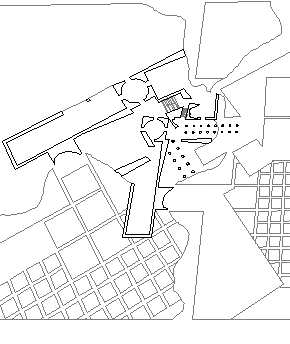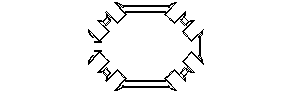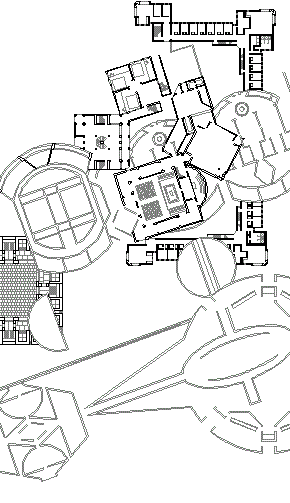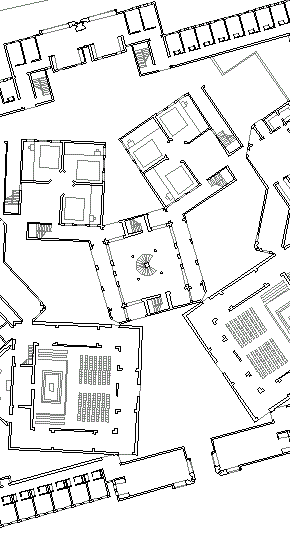
The reality is that the Ichnographia is not an abundant breeding of "symbols devoid of significance," rather a cleverly delineated and labeled narrative of ancient Rome's own Imperial history. Both the many individual building plans and the Latin labels thereof act as a readable text which delivers an accurate historical (and at times even an accurate archeological) account.

It is not true that Piranesi outright rejects historical and archeological reality with regard to "reconstructing" ancient Rome's Campus Martius. In fact, most the buildings labeled within the Ichnographia not only represent buildings that once existed within ancient Rome, but they are for the most part positioned in their respective proper locations. This is not to say, however, that the entire map is "accurate." Many of the individual plans, although designating buildings that once existed, are nonetheless Piranesi's own design creations. As to those portions of the Ichnographia that are purely imaginative and/or inaccurate, it is within these that Piranesi is also the most astute, because it is Piranesi's superficial "mistakes" that signal precisely where to look for a deeper message or meaning regarding ancient Rome's (and particularly the Campus Martius') overall history.
| |

It seems clear that it is precisely the "archeological mask" of the Campo Marzio that fooled Tafuri. Piranesi never intended the Ichnographia to be read as an archeological reconstruction, but as a wholly new reenactment of the Campus Martius. Piranesi's "experiment" is not in the design of the Campo Marzio per se, but in his Promethean delivery of historical (and architectural) narrative. As for the city delineated within the Ichnographia remaining an "unknown", this too is false because all one has to do is read (or translate) all the Latin labels within the Ichnographia to know the "city" it depicts.
After reading Piranesi's Campo Marzio properly, the notion of irrationality does not come into play. Piranesi's narrative method is indeed unprecedented, but his message does not carry an overt irrationally, nor even a covert irrationality. This latching on to the notion of irrationality within the Campo Marzio is perhaps Tafuri's most critical mistake because all subsequent reference (within Architecture and Utopia) to the presence of irrationality may be ostensibly based on a misguided and insubstantial premise. Unfortunately, it is Tafuri himself that "did not possess the means for translating the dynamic interrelationships" between plan forms and Latin labels which Piranesi used to "present" his historical narrative.
Interestingly enough, Piranesi did "equate" opposites, but not the opposites of rational and irrational. Piranesi looked to ancient Rome's own history and there recognized the opposites of Paganism and Christianity.
| |

In composing the Campo Marzio, Piranesi did not utilize a "method of arbitrary association." What Piranesi did was to carefully link and sometimes even align seemingly individual buildings so that as a result certain groups of buildings generate distinct narratives or meanings. As one penetrates Piranesi's Campo Marzio, it becomes ever clearer that Piranesi rarely positioned building plans within the Ichnographia arbitrarily. As mentioned before, if the building plans do not represent actual structures that once existed in ancient Rome, then they are there performing some part of a specific narrative.
It is regrettable that Tafuri did not recognize the Campo Marzio's true "organic unity."
| |

Through this quotation, Tafuri demonstrates his cursory observational procedure in examining the Campo Marzio. Although he correctly recognizes the axis running through the Bustum Hadriani, Tafuri does not note that this is the axis of death. Moreover, Tafuri does not detect the much longer axis of life that runs perpendicular to the axis of death. Additionally, the axes of the "Circus Agonnalis, of the Circus Flaminius, of the Templum Martis, of the Gimnasium Neronis, of the Terme [Baths] of Agrippa" do not even align let along act in concert with the axis of Hadrian's tomb. Tafuri should have known better than to even write that sentence, especially since he was carelessly copying the mistakes of Fasolo's 1956 text on the Campo Marzio.
As to the so-called "secondary alignment," Tafuri should have plainly cited this "rectilinear axis" as the Equiria, which Piranesi clearly labels as such. Without making the effort to investigate the Equiria, it is then no wonder that Tafuri found Piranesi's Campo Marzio a "formless tangle of spurious organisms."
| |

Language is certainly present throughout Piranesi's Campo Marzio. First there is the presence of the Latin language with the close to one thousand Latin words that appear as labels throughout the Ichnographia. Second, there is the unique language (and syntax) of Piranesi's individual building plans, which quite often act as pictograms that in turn impart meaning. Taking the Latin labels and the language of the plans together, moreover, delivers the most complete rendition of Piranesi's message.
4. generate an "acropolis dossier"
Is "ambiguous algorithm" an oxymoron?
How might a mannered algorithm function?
Can algorithms treat ambiguity unambiguously?
|